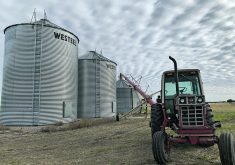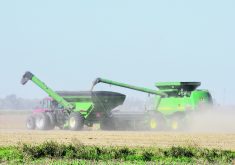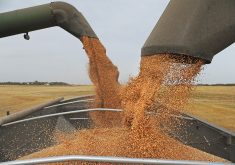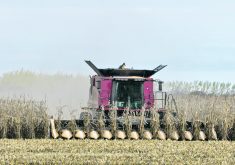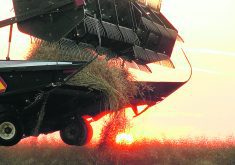Saskatchewan
SOUTH
Less then 10 percent of crops have been swathed or straight-cut, and less than five percent combined.
Harvest progress varies widely between southwest and southeast. Farmers have started combining winter wheat, lentils, field peas and fall rye, and swathing has begun for canola.
Many crops are about a week behind normal development for this time of year with reports of below average yields and poor quality because of excess moisture and root rot. Some crops may be swathed to minimize shattering if weather conditions do not improve.
Read Also

Volatile temperatures expected for this winter
DTN is forecasting a lot of temperature variability in the Canadian Prairies this winter. Precipitation should be close to average.
Precipitation varied from trace amounts to a high of 82 millimetres in the Stoughton area, while the Moosomin area continues to lead the province with 675 mm since April 1.
Topsoil moisture conditions on cropland are rated about 85 percent adequate. Hayland and pasture moisture is rated 75 percent sufficient.
Most crop damage, including lodging, was caused by strong winds, localized flooding and hail. Some areas continue to have issues with grasshoppers and wheat midge. Sclerotinia, rust, fusarium head blight and leaf spot diseases are also a concern in many crops.
CENTRAL
Harvest is slowly beginning with producers starting to desiccate and swath. Crops continue to average at least a week behind normal development.
Producers are swathing fall rye, winter wheat, field peas, canola and mustard.
Yields and quality are estimated to be average but are affected by higher disease levels and excess moisture.
Rainfall ranged from trace amounts to 50 mm in the Kindersley area. Since April 1, the Foam Lake area has received 586 mm of cumulative rainfall.
More than three-quarters of the topsoil moisture conditions on cropland, hay land and pastures are rated adequate.
Strong winds, heavy rain, localized flooding and hail caused most of the damage. Drought-like conditions can also be found in some fields. High levels of fusarium head blight, sclerotinia and rust can be found in some areas.
NORTH
Farmers have just begun desiccating pulses and swathing canola because of warm temperatures, although crops have not caught up to normal stages of development. Yields and quality are expected to be average.
Precipitation ranged from small amounts to 38 mm in the Neilburg area. The North Battleford area has received 483 mm of cumulative rainfall since April 1.
Topsoil moisture conditions on cropland, hay land and pastures are rated at about 80 percent adequate.
There are reports of higher than normal levels of fusarium head blight and wheat midge in some fields. Grasshoppers and lygus bugs are also causing problems.
Manitoba
SOUTHWEST
Welcomed precipitation varied from 10 to 30 millimetres.
Spring wheat, oat and barley crops are quickly maturing and within two weeks of swathing or preharvest glyphosate application.
Some areas have begun winter wheat harvest.
Quality and yields are reported poor. Fusarium damaged kernel levels range from five to 20 percent and test weight is low. Ergot levels are higher compared to previous years.
Most canola is much shorter than normal, and straight cutting has renewed interest.
Soybean maturity is more than a month away but advancing quickly with the warm temperatures.
Peas have been desiccated and are expected to be harvested within the week. Flax continues to look like it will have excellent yield potential.
Corn and sunflowers are still behind normal development.
Haying continues on native grass. Many acres remain wet and inaccessible. On the other hand, second cut hay continues, but many stands have poor regrowth due to hot, dry conditions. Green feed could also use more moisture.
Average yields are being reported from the silage barley harvest.
NORTHWEST
Good growing conditions prevailed with less than 13 mm of precipitation. Most of the wheat crop is in the dough stage while most canola and soybeans have podded. Field peas have fully podded.
Harvest of winter cereals and early seeded barley has started.
Good haying weather produced results. Native hay is being harvested in low spots that have dried up, but other areas remain affected by excess spring moisture
Pastures that have been continuously grazed are in average to poor condition, and rain is needed.
CENTRAL
Sunscald is evident in many fields as hot, humid conditions continue to advance crops.
Most areas received trace amounts of precipitation while a few pockets received 25-50 mm.
Topsoil moisture conditions are rated poor.



